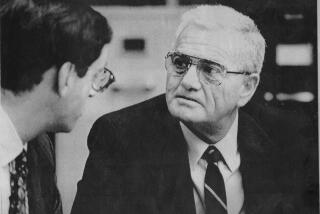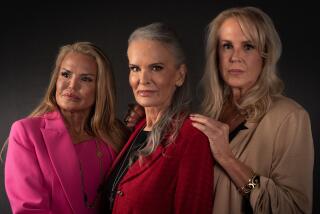A Tale of O.J. Simpson Like No Other . . . For Now
- Share via
Lawrence Schiller and James Willwerth have produced the best of a bad breed, the definitive book about the murder investigation and trial of O.J. Simpson. At least, the definitive book so far.
More detailed than the account by Johnnie L. Cochran, more honest than the one by Robert L. Shapiro, more mature than the tales told by prosecutors Christopher Darden and Hank Goldberg, more careful than the one by New Yorker writer Jeffrey Toobin, more complete than the book by journalist Joseph Bosco, more balanced than the one by former prosecutor Vincent Bugliosi. “American Tragedy: The Uncensored Story of the Simpson Defense” (Random House) earns its place in the overstocked library of Simpson reflections.
Like the books that have come before it--and undoubtedly the ones still to come--the latest entry to the Simpson canon contains the requisite bomblets, none of which will fundamentally alter anyone’s sense of the case but all of which flesh out its details. According to the authors:
* Before his famous flight from the law, O.J. Simpson roamed the home of his friend Robert Kardashian, searching for a place to kill himself.
* Simpson failed a polygraph examination so resoundingly that it rattled Kardashian and Shapiro. “That is about as bad as you can do,” Shapiro said upon hearing the results.
* Time and again, Simpson choreographed the moves of his high-powered but divided legal team. At one point, when the lawyers were preparing to dress down Superior Court Judge Lance A. Ito for a controversial ruling, Simpson insisted that they back off. “Some of these women [jurors] like Ito,” Simpson said. “The jury respects him.”
* Simpson’s lawyers methodically spruced up his home in time for a jury visit, going so far as to take down pictures of white women and hang a Norman Rockwell print of a young black girl being escorted to school by federal marshals. A nude picture of Paula Barbieri, Simpson’s girlfriend at the time, also was hidden from the jurors. “This has little to do with a search for the truth,” Schiller and Willwerth write of the preparations. “This is stagecraft.”
* Immediately after the jury announced that it had reached verdicts, defense lawyer Carl Douglas calculated how much time it would take for the panel to fill out the guilty forms and concluded that the verdicts had to be acquittals, a conclusion he shared with Simpson at the time. (I can attest to the truth of that anecdote; Douglas told me the same thing on the day before the verdicts were read to a waiting world.)
But the 720-page book, due out Monday, makes its real points through its tone and its detail, not its scoops. Schiller and Willwerth have produced a meticulously researched read, in contrast to their book’s closest rival, Toobin’s snappily written but flawed account.
Among other inaccuracies, Toobin manages to get the date of the 1992 riots wrong; more serious are his incomplete reporting on Cochran’s entry into the case and his misunderstanding of the important role that Simpson played in defending himself. Schiller and Willwerth are more careful reporters. Their book is better because of it.
Schiller’s access to Kardashian is a mainstay of his reporting, particularly in the book’s early sections, and Kardashian’s willingness to discuss the case with the author may have implications beyond this book. In fact, it may jeopardize Kardashian’s ability to steer clear of the civil case, since he may have lost his chance to continue asserting the attorney-client privilege regarding conversations with Simpson.
But Schiller’s reporting goes well beyond a reliance on Kardashian. Nearly the entire defense team is acknowledged, and many of the conversations and meetings the book recounts did not even involve Kardashian.
*
To be sure, “American Tragedy” is one-sided. From the start of the case, Schiller was closely identified with the Simpson camp: He interviewed Simpson in jail for the collection of musings titled “I Want To Tell You” (Little, Brown)--only loosely classifiable as a book, much less a good one. He associated with the defense team throughout the trial, and, as his book discusses, at one point he was called upon to do an important errand for Simpson’s lawyers.
But Schiller and Willwerth do not emerge as apologists for the man and lawyers whose trust Schiller appears to have won.
Advance speculation about “American Tragedy” has centered around the theory that it would show Simpson as guilty. Like most of the tabloid work on the Simpson case, that speculation is both wrong and overblown.
The book ultimately comes out neutral on the question of Simpson’s guilt, but it portrays the former football star and convicted wife beater as a megalomaniac whose antics and comments cause even his closest friends to entertain doubts about his innocence.
According to “American Tragedy,” Kardashian long harbored questions about the blood evidence pointing to Simpson as the likely culprit. Simpson’s first lawyer, Howard Weitzman, told Kardashian over lunch that he was convinced Simpson was guilty. Although lead defense lawyer Cochran was a stalwart believer in Simpson’s innocence, he too was troubled by his client’s inability to convincingly explain the source of cuts on his left hand. After arguing with Simpson one day in the holding cell, Cochran complained to his colleagues about their client’s efforts to sculpt Cochran’s closing argument. Describing their argument, Cochran fumed: “It’s a good thing I didn’t have blond hair.”
Shapiro, meanwhile, repeatedly flirted with the notion that his client was guilty. Again and again, according to the book, the lawyer signaled his doubts about Simpson’s innocence and talked about cutting a deal with the prosecution.
*
What’s more, Simpson’s behavior throughout the trial makes it clear that, guilty or innocent, he is thoroughly dislikable.
Take the day of the jury visit to Simpson’s home. As the panelists toured the house, Simpson watched from his front lawn, accompanied by lawyers and sheriff’s guards.
Eyeing the panelists as they ambled by, Simpson took a long look at a female alternate juror dressed in blue jeans. According to “American Tragedy,” he remarked: “Oh man, look at her in those pants. I want to get at her.”
But the central theme of Schiller’s book is that of a divided and bumbling defense team, one distracted by Shapiro’s unprofessionalism and F. Lee Bailey’s borderline incompetence. The book for the first time reveals the details of the December coup that led to Shapiro’s demotion in favor of Cochran. And it tracks the backbiting and sniping that hampered the defense team throughout.
Luckily for Simpson, that team was anchored by Cochran and his chief associate, Douglas, both of whom demonstrated cool heads and a savvy sense of their mission. Similarly, Shawn Chapman, another Cochran associate, is portrayed as a sensitive and thoughtful analyst of the evidence and of her client. By the time opening statements were delivered in 1995, Barry Scheck also had emerged as a key player in the defense, one whose command of the case went well beyond the DNA evidence.
Still, reading “American Tragedy” can’t help but make one wonder how this team would have fared against even a marginally effective crew of prosecutors. Instead, Simpson got lucky time and again, first benefiting from the prosecution’s unending ability to undermine its own case and then, most stunningly, from former Det. Mark Fuhrman’s self-immolation.
In the end, “American Tragedy” leaves little doubt that Simpson was defended by a lucky group of lawyers and was fortunate to have been prosecuted by an even wobblier group. It also makes clear that Simpson is, to put it mildly, a bad man.
Is he also a murderer? This book doesn’t answer. But the Simpson book parade isn’t over yet. There’s still Marcia Clark. . . .
More to Read
Sign up for our Book Club newsletter
Get the latest news, events and more from the Los Angeles Times Book Club, and help us get L.A. reading and talking.
You may occasionally receive promotional content from the Los Angeles Times.








